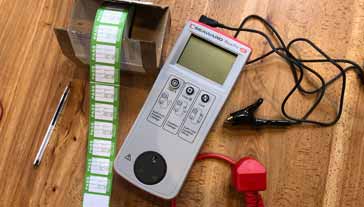What is PAT Testing: Portable Appliance Testing
PAT testing or portable appliance testing is a routine electrical test that is undertaken periodically to ensure the electrical safety of electrical safety of portable electrical devices and reduce the risk of electrical shocks.
PAT Testing - Portable Appliance Testing Includes:
PAT testing & testers: basics
As increased safety is needed these days with the ever increasing number of electrical appliances, and the much more rigorous approach to safety, a system of testing of electrical appliances is needed in many countries.
The testing goes by the name of PAT testing - Portable Appliance Testing. A PAT test is a routine electrical inspection and test of soem types of electrical appliance to check that they are safe to use. It's purpose is to ensure that electrical equipment is safe and to thereby reduce accidents and injuries in the workplace.
With many items of electrical equipment being heavily used, wiring and other aspects of the equipment can start to fail and give risk to an increased risk of electrical shock, short circuits and other issues.

What is a PAT test?
A PAT test, or portable appliance test includes a visual inspection to highlight and issues of wear, etc that might cause problems now, or those that might give rise to issues in the future.
The PAT test also tests the appliance using specialised PAT testers to provide a more in-depth check of the electrical state of the appliance. It tests for quantities including: earth continuity; lead polarity; insulation resistance, etc.
Once they have been PAT tested, each appliance should be marked as either "Passed" or "Failed." Any failed items must be quarantined until they are ether repaired or scrapped and disposed of. The items that fail a PAT test, must not be allowed to be used as they present a danger in use.
PAT testing is for portable appliances, and this can be a little vague. In general it includes seven categories of electrical appliance.
- Fixed appliances.
- Stationary appliances.
- IT appliances.
- Moveable appliances.
- Portable appliances.
- Cables and chargers.
- Hand Held appliances.
The legislation for PAT testing varies between countries. In soem there is no obligation for a form of portable appliance testing for electrical items. In others it is rigorously implemented.
For example in the UK is not a legal obligation, but there is a legal obligation to maintain electrical equipment in a safe condition. The same is true in some other countries as well.
PAT testing is one of the most effective ways to ensuring electrical appliances and equipment are safe at the time of testing, particularly for high risk or large, complex environments. As a result, PAT testing or similar schemes have become a standard way of meeting this legal obligation in countries where this is a requirement. In other countries, it can be a moral obligation to ensure electrical appliances are safe, and here a PAT testing or similar regime can be used to ensure the equipment is safe.
 Written by Ian Poole .
Written by Ian Poole .
Experienced electronics engineer and author.
More Test Topics:
Data network analyzer
Digital Multimeter
Frequency counter
Oscilloscope
Signal generators
Spectrum analyzer
LCR meter
Dip meter, GDO
Logic analyzer
RF power meter
RF signal generator
Logic probe
PAT testing & testers
Time domain reflectometer
Vector network analyzer
PXI
GPIB
Boundary scan / JTAG
Data acquisition
Return to Test menu . . .


